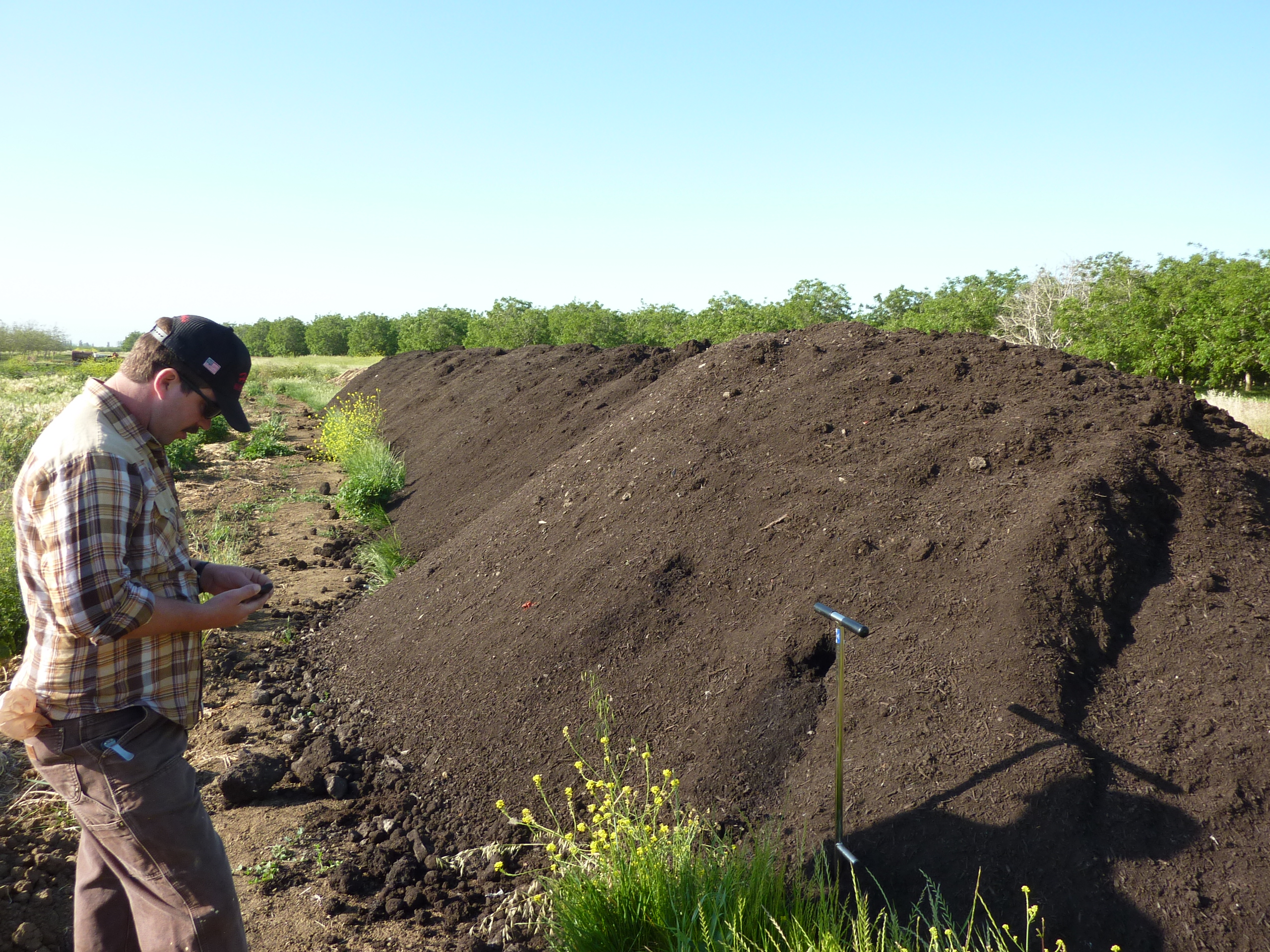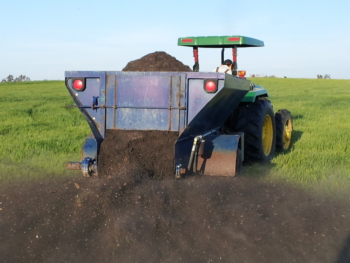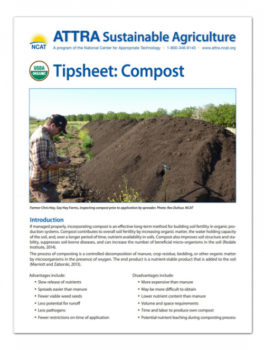Tipsheet: Compost

Farmer Chris Hay, Say Hay Farms, inspecting compost prior to application by spreader. Photo: Rex Dufour, NCAT
By Thea Rittenhouse, NCAT Agriculture Specialist
Introduction
If managed properly, incorporating compost is an effective long-term method for building soil fertility in organic production systems. Compost contributes to overall soil fertility by increasing organic matter, the water holding capacity of the soil, and, over a longer period of time, nutrient availability in soils. Compost also improves soil structure and stability, suppresses soil-borne diseases, and can increase the number of beneficial micro-organisms in the soil (Rodale Institute, 2014).
The process of composting is a controlled decomposition of manure, crop residue, bedding, or other organic matter by microorganisms in the presence of oxygen. The end product is a nutrient-stable product that is added to the soil (Marriott and Zaborski, 2013).
Advantages include:
- Slow release of nutrients
- Spreads easier than manure
- Fewer viable weed seeds
- Less potential for runoff
- Less pathogens
- Fewer restrictions on time of application
Disadvantages include:
- More expensive than manure
- May be more difficult to obtain
- Lower nutrient content than manure
- Volume and space requirements
- Time and labor to produce own compost
- Potential nutrient leaching during composting process
USDA Organic Regulations for Organic Compost 7 CFR § 205.203(c)
Composting and vermicomposting (worm composting) systems should be outlined in a grower’s Organic System Plan (OSP). Production records should include the source of all materials used in the compost. If animal materials (such as fish meal and bat guano) are used, accurate temperature monitoring logs need to be kept to demonstrate that compost reaches the optimal temperatures as per the NOP guidelines (listed below). Vermicomposting production records should include a time log and description of practices used to maintain adequate moisture and aerobic conditions.
“The producer must manage plant and animal materials to maintain or improve soil organic matter content in a manner that does not contribute to contamination of crops, soil, or water by plant nutrients, pathogenic organisms, heavy metals, or residues of prohibited substances” 7 CFR § 205.203(c)(2).
The NOP guidelines state that animal and plant materials for compost include: raw manure, composted plant and animal materials, and un-composted plant materials. Raw manure is restricted in use, and compost containing animal materials must be produced under certain conditions.
NOP-Approved Compost Materials/Feedstock
- Animal bedding and manure: Must meet requirements for raw manure. USDA Organic Regulations: § 205.203(c)(1)
- Crop residues
- Yard wastes
- Fish wastes and by-products
- Seaweed by-products
- Paper (must be newspaper or other recycled paper without glossy surface or colored ink)
- Green waste that has not been exposed to pesticides
- Guano—Bat or Bird (allowed with restrictions): Must be decomposed and dried deposits and must meet requirements for raw manure. USDA Organic Regulations: § 205.203(c)(1)
- Other nonsynthetic substances
NOP Time/Temperature Guidelines
Compost and vermicompost guidance parameters can be found in NOP 5021: Compost and Vermicompost in Organic Crop Production at www.ams.usda.gov/NOP ProgramHandbook
- Initial C: N ratio of between 25:1 and 40:1
- For an in-vessel or static aerated pile, compost should maintain a temperature of between 131°F ( 55°C) and 170°F (77°C) for three days.
- For a windrow system, this temperature must be maintained for 15 days and the pile turned a minimum of five times within that time period. Accurate temperature records are needed to satisfy the NOP standards.
- Incorporates acceptable feedstocks (see above list)

Compost-turning equipment at Groverat Grover Compost in the San Joaquin Valley, California. Compost must maintain a temperature between 131°F (55°C) and 170°F for 15 days and be turned a minimum of five times in that 15 day period for a windrow system. Photo: Rex Dufour, NCAT
Vermicompost USDA Organic Guidance
Vermicomposting occurs at room temperature using specific earthworms (e.g., Eisenia fetida) and microbial activities. Vermicompost systems can be set up indoors, and finished vermicompost usually has a higher nutrient level than typical compost. If using vermicompost, the NOP 5021 specifies the following conditions:
- Vermicompost is made from allowed feedstock materials (see above);
- Aerobic conditions are recorded and maintained by adding thin layers of organic matter at 1- to 3-day intervals;
- Moisture is maintained at 70% to 90%; and
- The vermicompost must cure for 6 to 12 months for outdoor windrows, 2 to 4 months for indoor container systems, 2 to 4 months for angled wedge systems, or 30 to 60 days for continuous-flow reactors.
Compost Teas
The NOP draft guidance on crop materials states that compost tea made from compost not meeting the requirements of § 205.203(c) or NOP 5021 is subject to restrictions of § 205.203(c)(1) for raw animal manure. The following guidelines were set forth by the National Organic Standards Board and are not regulatory requirements.
Use only potable water to make compost tea or to dilute it.
Sanitize all of the equipment used to prepare compost tea.
Make compost tea only from compost that has maintained a temperature of at least 131°F for three days and that has been mixed so all of the pile or windrow has heated up.
Avoid additives when fermenting compost tea, as these can promote the growth of harmful organisms. In particular, simple sugar sources, like molasses, should be avoided.
Additives can be used if sample batches of compost tea are tested before using it to make sure it meets the Environmental Protection Agency’s (EPA) Recreational Water Quality Criteria with regard to coliform bacteria. y
If compost tea is made with additives but is not tested, or if it doesn’t meet water quality guidelines, then food crops may not be harvested until 90 to 120 days after the compost tea has been applied (as with raw manure use on organic farms).
When is compost finished?
The compost pile is mixed or managed to ensure that all of the feedstock heats to the minimum of 131º F (55º C) for a minimum of three days. The active composting process is finished when the pile returns to ambient temperature levels. The monitoring of the above parameters must be documented in the OSP in accordance with § 205.203(c) and verified during the organic inspector’s site visit.
Compost that is 5° to 10° above ambient temperature cannot be counted as being finished and can actually be detrimental to plants because bacteria and fungi are still sequestering nutrients rapidly enough that plants can be harmed, and possibly die, as a result of the lack of available nutrients (Rodale Institute, 2014).
Food Safety Modernization Act Guidelines for Compost
The Food Safety Modernization Act (FSMA) requires the Food and Drug Administration (FDA) to develop regulations aimed at improving the safety of produce. These new regulations are set to be finalized in late 2015. Check here for the most up to date information on FSMA.
The new food safety standards may address topics such as the following:
- Definitions for determining whether the soil amendment is treated or untreated;
- Microbial standards applied to treatment processes;
- Application requirements and minimum interval requirements;
- The option to offer an alternative approach; y Instructions for how to convey, handle, and store soil amendments;
- Prohibitions on the use of human waste; and
- Recordkeeping requirements.
Producers should sign up for updates related to the new rules from organizations they trust.

On-farm windrow compost system. Photo: Rex Dufour, NCAT
Common Farm Compost Systems
Passive pile method — Compost feedstocks are stacked in a pile without turning, ventilating or monitoring temperatures. Compost produced by this method is subject to raw manure restrictions.
Windrow method — A mixture of compost feedstock is placed in a long narrow pile, which is turned on a regular basis. This method is approved for organic systems.
Aerated static pile — Compost feedstocks are piled, but instead of turning, oxygen is delivered through PVC pipes placed along the bottom of the pile. Piles can be five to eight feet high. This method is approved for organic farm systems.
How Much Compost Will You Need?
A typical farm will need five to 20 tons of compost per acre, depending on the present soil conditions and crops. It is a good idea to have an annual soil test to determine nutrient needs and to make sure the compost is not adding too much phosphorous to the soil (Rodale Institute, 2014).
Critical Components of Composting: Temperature, Moisture, and Oxygen
After the initial heating period to between 131°F and 171°F, the compost needs to cool down so that beneficial organisms can continue to thrive. It is important to monitor the compost temperature to make sure that there is sufficient oxygen for beneficial organisms.
When piles remain hot (above 131°F) for long periods, the lack of oxygen kills beneficial fungi, protozoa, and nematodes that help retain key nutrients. It is important to balance the temperature with the right amount of turnings to bring oxygen into the pile. Keeping accurate track of the temperature of the pile is important so that the pile is hot enough to kill pathogens and weed seeds, but not overheated so that other beneficials are killed, too (Rodale Institute, 2014).
An adequate supply of moisture and oxygen is needed for a compost pile to break down efficiently. The moisture content should be between 40% and 65% in an active compost pile. The optimal pH is between 6.5 and 8.
To check the moisture level, dig into the pile at least one foot, pick up a handful of compost, and squeeze. You should feel liquid, or at least a few drops of liquid will be squeezed out (Rodale Institute, 2014).
Compost Application Rates
Compost should be considered a slow-release source of nitrogen (N). Most N remaining after the composting process is bound into organic forms and thus not available immediately for plant uptake. Compost applied at rates high enough to meet immediate crop N requirements will almost always result in excess phosphorus (P) and potassium (K) application. Excess P can cause surface water pollution (and potentially threaten organic certification). In some cases, excess K can upset crop nutrition balance (Baldwin and Greenfield, 2009).
Compost application rates can be calculated using fertilizer recommendations from soil tests and compost nutrient analysis. General guidelines suggest that 10% to 25% of compost N will be plant-available during the first year of application. P and K availability in the first year is between 40% and 60%. These are general guidelines, and actual availability will depend on the compost quality (Baldwin and Greenfield, 2009).
Calculating application rates for compost is similar to figuring the application rates for manure on cropland. First, estimate the nitrogen (N), phosphate (P) and potassium (K) requirement for the crop (based on realistic yield expectations for a particular soil or field). A chemical analysis will show the N-P-K content of the compost. Then calculate a compost rate based on N, P, or K as the critical or priority nutrient.
The amount of compost to apply is calculated from the recommended rate of the priority nutrient and the plant-available nutrient content of the compost. Plant-available Nitrogen (PAN) is the amount of nitrogen made available to the plant in the growing season after fertilizing materials have been applied. Compost application rates are based on PAN rather than the total nitrogen. The C: N ratio of mature compost is commonly in the range of 8:1 to 14:1.

Compost Spreader at Say Hay Farms, Woodland, California. Photo: Rex Dufour, NCAT
Useful Equipment/Tools for Making Compost
- Front-end loader to mix compost in windrow composting
- Manure spreader: not always necessary but helpful for spreading large amounts of compost
- Thermometer with 2-foot to 3-foot probe (36-inch dial thermometer)
- PVC pipes for aeration to center of pile in larger windrow systems
Sources of Chemical Contamination of Compost in Organic Systems
It is important to be aware of the potential for prohibited substances to contaminate compost that is being used from off-farm sources in organic systems. Refer to the USDA organic regulations, the NOP Handbook, and the National List of Allowed and Prohibited Substances for more information.
Arsenic in Chicken Litter
The use of broiler litter as a feedstock for compost production poses some particular concerns. Arsenic is a component of some feed medications or growth promoters used in commercial broiler operations, although the FDA recently has been limiting their use in poultry operations. The majority of arsenic consumed by poultry is excreted and incorporated into the litter, leading to the potential for build-up in the soil and leaching from compost piles into lakes and streams (Bellows, 2005).
References
Baldwin, K. R., and J. T. Greenfield. 2009. Composting on organic farms. Organic Production Publication Series, Center for Environmental Farming Systems. North Carolina Cooperative Extension Service, Raleigh, NC.
Bellows, Barbara. 2005. Arsenic in Poultry Litter: Organic Regulations. ATTRA Publication.
Doohan, D., and Michel, F. 2009. Clopyralid and other Pesticides in Compost. Ohio State University Extension Fact Sheet online version.
Lamb, J., Moncada, K., and Sheaffer, C. 2010. Chapter 4: Soil Fertility.
Marriott, E., and Zaborski, E. 2013. Making and Using Compost for Organic Farming.
Rodale Institute. 2014. Transition to Organic: Waste Management.
Rodale Institute. 2014. Improved Compost Management for Certified Organic Farms.
USDA Organic Regulations 7 CFR 205.
USDA National List of Allowed and Prohibited Substances.
Further Resources
USDA National Organic Program Handbook
The following documents are within the NOP handbook, and contain information about compost in organic production systems:
NOP 5016: Allowance of Green Waste in Organic Production Systems
NOP 5006: Processed Animal Manure in Organic Crop Production NOP 5021: Compost and Vermicompost in Organic Crop Production
NOP 2602: Recordkeeping of Certified Operations
NOP 2610: Sampling Procedures for Residue Testing
PM 11-4: Evaluation of Materials Used in Organic Crop, Livestock, and Handling Operations
Composting: You can do it! ATTRA video.
Compost. Rodale Institute Farm
The Art and Science of Composting. University of Wisconsin-Madison.
Tipsheet: Compost
By Thea Rittenhouse, NCAT Agriculture Specialist
Published July 2015
©NCAT
IP448 Slot 454
This publication is produced by the National Center for Appropriate Technology through the ATTRA Sustainable Agriculture program, under a cooperative agreement with USDA Rural Development. This publication was also made possible in part by funding from t U.S. Department of Agriculture’s Agricultural Marketing Service, National Organic Program. ATTRA.NCAT.ORG.


